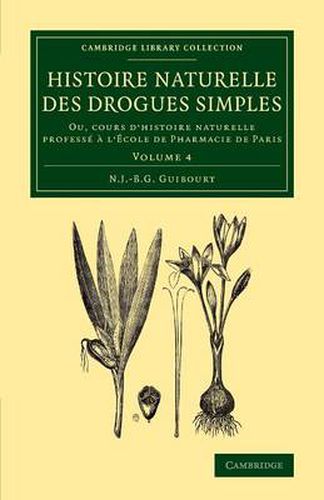Readings Newsletter
Become a Readings Member to make your shopping experience even easier.
Sign in or sign up for free!
You’re not far away from qualifying for FREE standard shipping within Australia
You’ve qualified for FREE standard shipping within Australia
The cart is loading…






The French pharmacist Nicolas Jean-Baptiste Gaston Guibourt (1790-1867) first published this work in two volumes in 1820. It provided methodical descriptions of mineral, plant and animal substances. In the following years, Guibourt became a member of the Academie nationale de medicine and a professor at the Ecole de pharmacie in Paris. Pharmaceutical knowledge also progressed considerably as new methods and classifications emerged. For this revised and enlarged four-volume fourth edition, published between 1849 and 1851, Guibourt followed the principles of modern scientific classification. For each substance, he describes the general properties as well as their medicinal or poisonous effects. Volume 4 (1851) looks at pharmaceutical substances derived from animals. Guibourt draws on Cuvier’s recent classificatory work, dividing animals into four groups: vertebrates (mammals, birds, reptiles, fish), articulates (insects, arachnids, crustaceans et al.), molluscs, and zoophytes.
$9.00 standard shipping within Australia
FREE standard shipping within Australia for orders over $100.00
Express & International shipping calculated at checkout
The French pharmacist Nicolas Jean-Baptiste Gaston Guibourt (1790-1867) first published this work in two volumes in 1820. It provided methodical descriptions of mineral, plant and animal substances. In the following years, Guibourt became a member of the Academie nationale de medicine and a professor at the Ecole de pharmacie in Paris. Pharmaceutical knowledge also progressed considerably as new methods and classifications emerged. For this revised and enlarged four-volume fourth edition, published between 1849 and 1851, Guibourt followed the principles of modern scientific classification. For each substance, he describes the general properties as well as their medicinal or poisonous effects. Volume 4 (1851) looks at pharmaceutical substances derived from animals. Guibourt draws on Cuvier’s recent classificatory work, dividing animals into four groups: vertebrates (mammals, birds, reptiles, fish), articulates (insects, arachnids, crustaceans et al.), molluscs, and zoophytes.